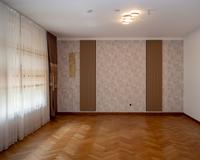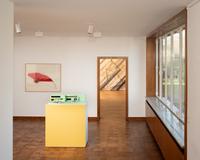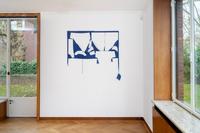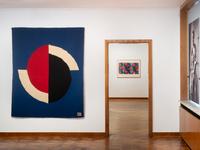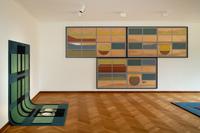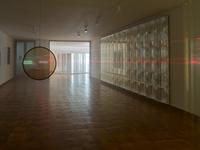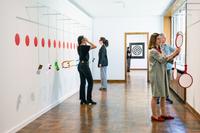Anna K.E.For Our ParentsHLHE DIALOGUE–Haus Esters
Opening: October 6, 11.30 a.m.
Anna K.E. (b. 1986 in Tbilisi, Georgia, lives in New York, USA) develops architectural constructions, settings, and sculptural models, as well as spontaneously filming her own actions in order to trace the relationship between the subjective body and the social environment. Modern architecture of the early twentieth century always plays a key role in her work. Anna K.E. playfully and anarchically breaks through norms and fixed social structures. Her work is concerned with the human dimension in an environment characterized by both lack of stability and freedom. For her exhibition at Haus Esters, Anna K.E. is developing a total installation with new works related to the site.
After graduating from the Düsseldorf Academy of Art, Anna K.E. has been honored with numerous international awards and exhibitions and was featured in the Georgian Pavilion at the 2019 Venice Biennale.
ATTENTION! IMPORTANT WARNING: Strong magnetic fields inside Haus Esters. Technical devices (pacemakers, cell phones), data storage devices, and magnetic strips (bank cards, ID cards) can be disturbed.
Curator: Sylvia Martin
Since 2017, the Kunstmuseen Krefeld have been conceiving exhibitions in the neighboring villas Haus Lange and Haus Esters that enter into dialogues with each other—between art and design, between generations, or between themes and related content. This series now continues with Marion Baruch and Anna K.E., two artists who are separated by two generations but whose approaches are linked by similar themes, including performative and participatory elements and the playful linking of art and design. Both work with the human body as an instrument of measurement and emotional stimulus.
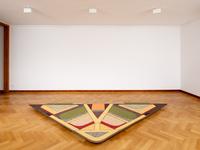
Installation view, Haus Esters, Kunstmuseen Krefeld 2024
© the artist, Barbara Thumm Gallery
Photo: Dirk Rose
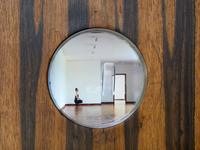
Installation view, Haus Esters, Kunstmuseen Krefeld 2024
© the artist, Barbara Thumm Gallery
Photo: Dirk Rose
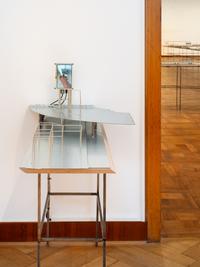
Installation view, Haus Esters, Kunstmuseen Krefeld 2024
© the artist, Barbara Thumm Gallery
Photo: Dirk Rose
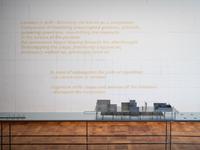
Installation view, Haus Esters, Kunstmuseen Krefeld 2024
© the artist, Barbara Thumm Gallery
Photo: Dirk Rose
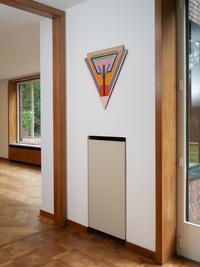
Installation view, Haus Esters, Kunstmuseen Krefeld 2024
© the artist, Barbara Thumm Gallery
Photo: Dirk Rose
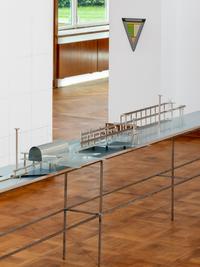
Installation view, Haus Esters, Kunstmuseen Krefeld 2024
© the artist, Barbara Thumm Gallery
Photo: Dirk Rose
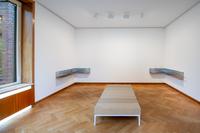
Installation view, Haus Esters, Kunstmuseen Krefeld 2024
© the artist, Barbara Thumm Gallery
Photo: Dirk Rose
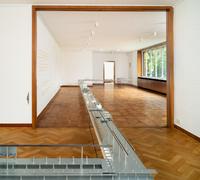
Installation view, Haus Esters, Kunstmuseen Krefeld 2024
© the artist, Barbara Thumm Gallery
Photo: Dirk Rose
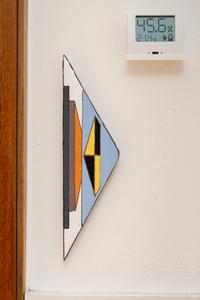
Installation view, Haus Esters, Kunstmuseen Krefeld 2024
© the artist, Barbara Thumm Gallery
Photo: Dirk Rose
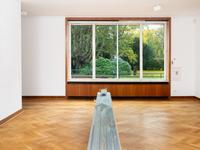
Installation view, Haus Esters, Kunstmuseen Krefeld 2024
© the artist, Barbara Thumm Gallery
Photo: Dirk Rose
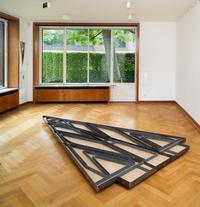
Installation view, Haus Esters, Kunstmuseen Krefeld 2024
© the artist, Barbara Thumm Gallery
Photo: Dirk Rose
Exhibitions currently on view
Related past exhibitions

Gregor Schneider. Welcome, Installation view at Haus Esters, Krefeld 2025 Copyright: VG Bild-Kunst, Bonn 2025 Photo: Dirk Rose Past exhibitionGregor SchneiderWelcome–Haus Esters
Partly FurnishedExcellent View
Installation view
Haus Lange, Kunstmuseen Krefeld 2025
Collection Kunstmuseen Krefeld
© the artists, VG Bild-Kunst Bonn, 2025
Photo: Dirk RosePast exhibitionPartly Furnished, Excellent View. Site-specific Art for Haus Lange Haus EstersHLHE DIALOGUE The Special Site–Haus Lange
Marion Baruch. Social Fabric
Installation view, Haus Lange, Kunstmuseen Krefeld 2024
© the artist, Galerie Urs Meile, Beijing-Lucerne and Sommer Contemporary Art, Tel Aviv-Zurich & Sammlung Kunstmuseen Krefeld Photo: Dirk RosePast exhibitionMarion BaruchSocial FabricHLHE DIALOGUE–Haus Lange
Sonia Delaunay, Maison Sonia, Kunstmuseen Krefeld 2022, installation view
© Pracusa S.A., photo: Dirk RosePast exhibitionMaison Sonia. Sonia Delaunay and the Atelier SimultanéHL HE Dialog–Haus Lange
Andrea Zittel, Personal Patterns, Kunstmuseen Krefeld 2022, installation view
© Andrea Zittel, photo: Dirk RosePast exhibitionAndrea ZittelPersonal PatternsHL HE Dialog–Haus Esters
Installation view Adolf Luther Interactive Spatial Experiences, HLHE Dialogue, 2022
Kunstmuseen Krefeld
© VG Bild-Kunst, Bonn 2022 / Photo: Simon VogelPast exhibitionAdolf LutherInteractive experience spacesHL HE Dialog–Haus Esters
Installation view Julio Le Parc Interactive Spatial Experiences, HLHE Dialogue, 2022
Kunstmuseen Krefeld
© VG Bild-Kunst, Bonn 2022 / Photo: Andreas BischofPast exhibitionJulio Le ParcInteractive experience spacesHL HE Dialog–Haus Lange
Past related programme
- Guided tour
Marion Baruch Anna K.E. HLHE DialogMore–Haus Esters, Haus LangeFührung mit Thomas Janzen
Kosten: Museumseintritt zzgl. 4 Euro- Guided tour
Anna K.E.More–Haus EstersFührung mit Sabine Sander-Fell
Kosten: Museumseintritt zzgl. 4 EuroErleben Sie die faszinierende Kunst von Anna K.E. in einer Führung durch Haus Esters. In ihrer Ausstellung Für unsere Eltern verwandelt Anna K.E. die historische Architektur des Gebäudes in ein dynamisches Feld, das die Beziehung von Körper, Raum und Wahrnehmung auf eine ungewöhnliche Weise neu interpretiert. Spielerisch verwandelt sie die vernachlässigten Ecken, Wände und Böden in ein spannendes Spiel von Farben und Formen. Entdecken Sie, wie die Künstlerin mit Materialien wie Magneten, Pflanzensamen und Emaille eine abstrakte Architektur erschafft, die den Raum neu gestaltet und zum Nachdenken anregt.
- Dialogführung
Zum Verhältnis von Architektur und Physis bei Anna K.E.More–Haus EstersFührung mit Melissa Blau
Kosten: Museumseintritt zzgl. 4 Euro- Guided tour
Marion Baruch, Anna K.EHLHE DialogMore–Haus Esters, Haus LangeFührung mit Thomas Müller
Kosten: Museumseintritt zzgl. 2 Euro- KuratorInnenführung
Anna K.E.mit Sylvia Martin
Museumseintritt zzgl. 2 EuroMore–Haus EstersErleben Sie die faszinierende Kunst von Anna K.E. in einer Führung durch Haus Esters. In ihrer Ausstellung Für unsere Eltern verwandelt Anna K.E. die historische Architektur des Gebäudes in ein dynamisches Feld, das die Beziehung von Körper, Raum und Wahrnehmung auf eine ungewöhnliche Weise neu interpretiert. Spielerisch verwandelt sie die vernachlässigten Ecken, Wände und Böden in ein spannendes Spiel von Farben und Formen. Entdecken Sie, wie die Künstlerin mit Materialien wie Magneten, Pflanzensamen und Emaille eine abstrakte Architektur erschafft, die den Raum neu gestaltet und zum Nachdenken anregt.
- Event
- Families
Treffen der GenerationenNachmittag für Jung und Alt, Workshops, Führungen etc.Ohne Anmeldung, nur MuseumseintrittMore–Haus Esters, Haus LangeZu den Ausstellungen Marion Baruch. Soziales Gewebe und Anna K.E. Für unsere Eltern – HLHE DIALOG
Ein Nachmittag für Jung und Alt zu Marion Baruch und Anna K.E. mit spielerischen Führungen, Workshops und ÜberraschungenMit den beiden Künstlerinnen Anna K.E. (1986) und Marion Baruch (1929) treffen in Haus Lange Haus Esters zwei künstlerische Generationen aufeinander. Beide verbindet das Interesse am Körper als Maßstab für die Wahrnehmung von Raum, Bewegung und Interaktion. Unter dem Motto Treffen der Generationen laden wir Familien, Jung und Alt ein, mit uns Museum gemeinsam zu erleben: In kurzweiligen Führungen erkunden wir spielerisch die beiden Ausstellungen und gestalten in kreativen Workshops Mandalas und kleine textile Objekte, die untereinander getauscht werden dürfen.
Programm:
14 Uhr: Weich, süß oder krümelig: Spielerische Familienführung mit allen Sinnen, Treffpunkt Haus Lange
15 Uhr: Kunst und Kuchen: Gemeinsamer Kaffeeklatsch für Jung und Alt, Treffpunkt Haus Esters oder bei gutem Wetter auf der Terrasse von Haus Lange
15.30 bis 17 Uhr: Erzähl doch mal: Kurzführungen zu beiden Ausstellungen für Erwachsene und Kinder, je 20 Minuten, Treffpunkt Haus Lange
15.30 bis 17 Uhr: Kunsttauschbörse: Farbenfrohe Mandalas und lustige Textilobjekte gestalten und miteinander tauschen, Treffpunkt im Vermittlungsraum im 1. OG in Haus Lange
- KunstImPuls
KunstImPuls – Body CheckMuseum live erleben mit der SWK AG und der Sparkasse KrefeldMore–Haus Esters, Haus LangeBeim KunstImPuls im November dreht sich alles um die neuen Ausstellungen Marion Baruch. Soziales Gewebe und Anna K.E. Für unsere Eltern in Haus Lange beziehungsweise Esters. Neben zahlreichen Führungen und Werkgesprächen darf man sich unter anderem auf einen Textilworkshop mit der in Krefeld lebenden Künstlerin Maike Jansen freuen.
Programm:
Führungen zu den neuen Ausstellungen von Anna K.E. und Marion Baruch
Gib Stoff - Weben, Collagieren, Experimentieren - Textilworkshop mit Maike Jansen
Banh Mi Bay am Haus Lange mit Drinks & Food
Elektro- und Techno-Sounds mit DJ OSE
- Guided tour
Anna K.E.More–Haus EstersErleben Sie die faszinierende Kunst von Anna K.E. in einer Führung durch Haus Esters. In ihrer Ausstellung Für unsere Eltern verwandelt Anna K.E. die historische Architektur des Gebäudes in ein dynamisches Feld, das die Beziehung von Körper, Raum und Wahrnehmung auf eine ungewöhnliche Weise neu interpretiert. Spielerisch verwandelt sie die vernachlässigten Ecken, Wände und Böden in ein spannendes Spiel von Farben und Formen. Entdecken Sie, wie die Künstlerin mit Materialien wie Magneten, Pflanzensamen und Emaille eine abstrakte Architektur erschafft, die den Raum neu gestaltet und zum Nachdenken anregt.
- Guided tour
Marion Baruch, Anna K.E.HLHE DIALOGMuseumseintritt zzgl. 2 €More–Haus Esters, Haus Lange- Ferienkurs
- Children & teens
Architektur mit anderen Augen sehenKosten: 40 €, ab 6 Jahre, Mittagssnack mitbringen Anmeldung über servicekunstmuseen@krefeld.de oder unter Tel. 02151 97558 137More––––Haus Esters, Haus LangeDie Künstlerin Anna K.E. erforscht die Architektur der modernen Villa Haus Esters von Ludwig Mies van der Rohe mit künstlerischen Mitteln: Sie schaut sich dafür ganz besonders jene Räume, Ecken und Wände an, die eher unscheinbar sind. Im Ferienkurs testen wir kreative, spielerische Methoden, um Baumaterialien zu erkunden und Räume neu zu vermessen. Wie viele Kinderschritte ist die Halle lang? Aus was sind eigentlich die Fensterbänke gemacht? Und kann man Räume auch mit anderen Sinnen als den Augen erkunden? Wie klingt zum Beispiel das Treppenhaus? Wie fühlen sich die Böden in den verschiedenen Räumen an? Wir zeichnen Grundrisse, denken uns alternative Wandgestaltungen aus und entwickeln so unser eigenes Fantasie-Architekturmodell.
- Guided tour
Architektur und das Performative bei Anna K.E.Museumseintritt zzgl. 2 €More–Haus Esters- LehrerInnenführung
Marion Baruch, Anna K.E.HLHE DIALOGFührung für Lehr- und Erziehungskräfte
Eintritt frei, mit AnmeldungMore–Haus Esters, Haus Lange- Opening
Marion Baruch, Anna K.E.HLHE DIALOGUEMoreHaus Esters, Haus Lange
